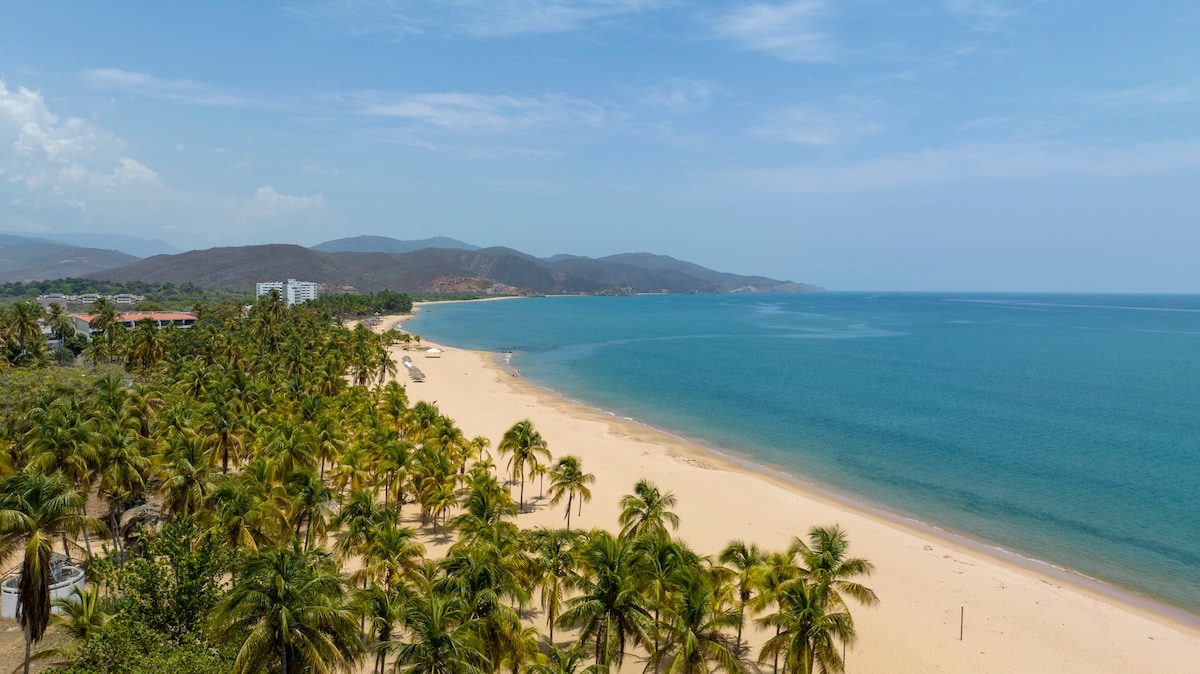
Key Takeaways:
-
Cumaná blends rich colonial history with tropical beaches and vibrant local culture for travelers seeking year-round adventures.
-
From hiking national parks to exploring centuries-old forts and enjoying Caribbean coastline views, the city offers something for everyone.
-
Visitors love Cumaná for its affordable travel, friendly locals, and combination of nature, history, and authentic Venezuelan charm.
Cumaná, the capital of Sucre State in Venezuela, holds the title of the oldest continuously inhabited European-founded city in South America. Founded in 1521, its location between the Caribbean Sea and lush mountains makes it an ideal destination for both history buffs and nature lovers. Known for its colonial forts, colorful waterfronts, and proximity to national parks, Cumaná blends old-world beauty with lively modern culture. Travelers are drawn to the area’s laid-back coastal vibe, rich cultural landmarks, and access to nearby islands and tropical adventures. Whether you’re here for exploration, relaxation, or local food, Cumaná gives you a taste of authentic Venezuela.
Table of Contents
-
Explore Castillo de San Antonio de la Eminencia
-
Relax on Playa San Luis
-
Visit Museo Gran Mariscal de Ayacucho
-
Hike the Mountains of Mochima National Park
-
Take a Ferry to Isla Arapo
-
Walk the Historic Waterfront Promenade
-
Attend the Festival of Virgen del Valle
-
Try Fresh Arepas at Mercado Municipal
-
Go Birdwatching in the Manzanares River Delta
-
Visit the House of Poet Andrés Eloy Blanco
1. Explore Castillo de San Antonio de la Eminencia
Perched high above Cumaná, the Castillo de San Antonio de la Eminencia offers not only a deep dive into colonial history but also panoramic views of the entire city and its coastline. Built in the 17th century to defend against pirate attacks, this fortress stands as a symbol of the city’s historical resilience. Visitors can walk along its thick stone walls, climb lookout towers, and view restored cannons still guarding the horizon. Interpretive signs and guided tours help bring its stories to life.
The castle is well-maintained and open year-round, making it a perfect start to your exploration of Cumaná’s heritage. Sunsets here are particularly striking, casting golden light across the fortress and the city below. It’s a fantastic photo opportunity and a peaceful place to reflect on the centuries of conflict and triumph that shaped the region. A visit here offers a perfect blend of history, architecture, and sweeping natural beauty.
2. Relax on Playa San Luis
One of the most popular beaches near Cumaná, Playa San Luis features soft white sands, palm trees, and calm turquoise waters ideal for swimming. Located just a short ride from the city center, it’s a local favorite for both relaxation and weekend gatherings. Vendors sell everything from grilled fish to tropical juices, and beachgoers can rent umbrellas or lounge chairs for a small fee. The relaxed atmosphere makes it easy to spend an entire day soaking up the sun.
While weekdays are quieter, weekends come alive with music, families, and impromptu volleyball games. Water temperatures stay warm throughout the year, making this a reliable destination regardless of season. There are also nearby restaurants and seafood shacks for post-beach meals. Whether you’re a solo traveler looking for tranquility or visiting with friends, Playa San Luis delivers on the perfect beach experience.
3. Visit Museo Gran Mariscal de Ayacucho
This museum is dedicated to Antonio José de Sucre, a national hero and one of South America’s most important figures in the struggle for independence. Housed in a colonial-style building in the city center, the Museo Gran Mariscal de Ayacucho offers exhibits on Sucre’s life, military campaigns, and contributions to Latin American history. The collection includes original documents, personal belongings, and artifacts from the early 19th century.
It’s an excellent place to understand Venezuela’s role in the broader independence movement and the legacy of one of its most revered figures. Entry is usually free or very affordable, and the staff are helpful and knowledgeable. Visitors leave with a stronger appreciation for the country’s historical roots and the figures who shaped its identity. It’s a cultural stop that complements the more scenic attractions around Cumaná.
4. Hike the Mountains of Mochima National Park
Mochima National Park, just west of Cumaná, is a sprawling protected area known for its rugged mountains, island-dotted coastline, and marine biodiversity. While most visitors flock to its beaches, the park also features incredible hiking trails that offer views of cliffs, forests, and the sea. Starting from various trailheads near the park entrance, hikers can ascend to elevated points that reveal sweeping vistas of the Caribbean below.
Trails vary in difficulty, making it accessible for casual walkers and serious trekkers alike. Along the way, you may spot iguanas, tropical birds, or even dolphins off the coast. The air is fresh, the scenery untouched, and the connection with nature is immediate. It’s a rejuvenating alternative to city sightseeing and a great way to experience Venezuela’s raw natural beauty.
5. Take a Ferry to Isla Arapo
For a more secluded and adventurous outing, take a ferry to Isla Arapo, part of the Mochima National Park marine system. This small, lesser-known island is prized for its crystal-clear water, snorkeling opportunities, and untouched beaches. Most ferries leave from nearby ports and the ride is scenic, offering views of green cliffs and marine life below the surface. It’s an easy half-day or full-day trip that feels like a mini island escape.
Once on the island, visitors can explore coves, hike lightly forested trails, or just lay out under the sun without the crowds. Snorkeling near the rocky outcroppings reveals vibrant coral reefs and schools of tropical fish. Bring your own gear or rent locally before boarding. For travelers seeking quiet beauty and natural immersion, Isla Arapo delivers a truly off-the-grid experience.
6. Walk the Historic Waterfront Promenade
Cumaná’s waterfront promenade, known locally as the “Malecón,” is a scenic stretch that runs along the coast, offering a refreshing place to walk, jog, or simply sit and watch the sea. Colorful colonial-style buildings, public art, and local food stalls line the route, making it as much a cultural walk as it is a visual one. In the evenings, the promenade comes alive with families, couples, and street performers. The ocean breeze and soft lighting make it a peaceful way to wind down your day.
You’ll find plenty of benches, shaded spots, and vendors selling coconut water, churros, and fried plantains. It’s a great area for people-watching and getting a feel for everyday life in Cumaná. Musicians often play along the way, and on weekends you might catch impromptu dancing or small festivals. It’s one of the most walkable parts of the city and a lovely way to connect with locals in a relaxed setting.
7. Attend the Festival of Virgen del Valle
Each September, Cumaná celebrates the Festival of Virgen del Valle, one of the most important religious and cultural events in the region. Devotees gather to honor the patron saint of eastern Venezuela with processions, masses, music, and food. The city fills with energy, and coastal communities decorate their boats in vibrant colors to carry the Virgin’s image in maritime parades. It’s a deeply spiritual and community-driven celebration.
Beyond the religious elements, the festival also features concerts, artisan markets, fireworks, and dance performances. Visitors are always welcome, and the inclusive spirit of the celebration makes it easy to participate. It’s a great time to see traditional clothing, music, and cuisine in full display. If your visit aligns with the festival, consider it a lucky chance to see Cumaná at its most vibrant and united.
8. Try Fresh Arepas at Mercado Municipal
Cumaná’s central market—Mercado Municipal—is the beating heart of local commerce and cuisine. Among the produce stalls and spice vendors, you’ll find food counters serving fresh Venezuelan arepas filled with everything from shredded beef to black beans and cheese. The air is filled with the aroma of grilled cornmeal patties, strong coffee, and tropical fruit juices. It’s not just a place to eat—it’s a sensory experience.
Locals shop here daily, so it’s a great place to strike up conversations and learn about everyday life in Cumaná. Prices are very affordable, and portions are generous. In addition to food, you’ll also find handmade crafts and household items. For the adventurous traveler, the market offers an authentic, unfiltered taste of the city and its flavors.
9. Go Birdwatching in the Manzanares River Delta
For nature lovers, the Manzanares River Delta just outside the city is a quiet retreat rich in birdlife and native vegetation. The wetland habitat supports dozens of species, including herons, ibises, and colorful kingfishers. Early mornings and late afternoons are ideal for spotting wildlife along the riverbanks or from small boats. Guided eco-tours are available for those interested in deeper exploration.
The delta is peaceful, with very little traffic or noise, making it a great break from urban sightseeing. Pack your binoculars, a hat, and some water, and you’ll be rewarded with close encounters with Venezuela’s natural side. Photographers in particular will appreciate the light and reflections on the water. It’s a hidden gem that adds ecological depth to your Cumaná itinerary.
10. Visit the House of Poet Andrés Eloy Blanco
Andrés Eloy Blanco, one of Venezuela’s most beloved poets and political figures, was born in Cumaná. His childhood home has been converted into a small but heartfelt museum celebrating his life and work. Inside, you’ll find original manuscripts, photographs, and personal belongings that trace his journey from small-town poet to national icon. The house itself retains its original charm, with wooden beams, colonial tiles, and lush gardens.
Literature lovers will appreciate the quiet reverence of the space and the chance to engage with Venezuelan poetry on a personal level. Entry is free or low-cost, and staff are often available to provide context or read selections aloud. It’s a cultural stop that adds an artistic layer to your understanding of the city. The home sits tucked in a quiet neighborhood—an oasis of thought and history in the middle of town.
What to do if you have kids?
Cumaná offers plenty of family-friendly options, whether your kids enjoy nature, beaches, or hands-on experiences. Mochima National Park has calm beaches for safe swimming, and the city’s waterfront promenade is great for walking and people-watching. Visiting Castillo de San Antonio is also a hit with kids, thanks to its towers and wide-open spaces. Restaurants are casual and welcoming, and locals are generally warm toward families. Bringing snacks, sunblock, and a beach towel can turn any outing into a smooth day of fun.
Where can I find free events in Cumaná Venezuela taking place this weekend?
To discover free events happening in Cumaná this weekend—whether it’s a pop-up market, street performance, or family-friendly cultural event—use PlanMyWeekend.ai. This smart event-finding tool helps you instantly uncover local experiences without digging through social media or outdated event pages. Whether you’re looking for something spontaneous or planning a full weekend itinerary, it’s the easiest way to find what’s happening now.
Final thoughts
Cumaná is one of those rare places where history, nature, and local culture intertwine effortlessly. Whether you’re admiring colonial forts, sailing to island beaches, or eating arepas in a busy market, the city offers rich experiences for every kind of traveler. It’s laid-back yet full of discovery, affordable yet endlessly rewarding. If you’re looking to explore an underrated coastal gem in Venezuela, Cumaná deserves a spot at the top of your list.
Author: Dejon Brooks
Dejon Brooks is an entrepreneur who founded Trend Watchers with his life savings. Aged 24, Dejon has turned Trend Watchers into a successful business. After reaching over 150M+ people on his personal accounts, he now spends his time growing Planmyweekend.ai


